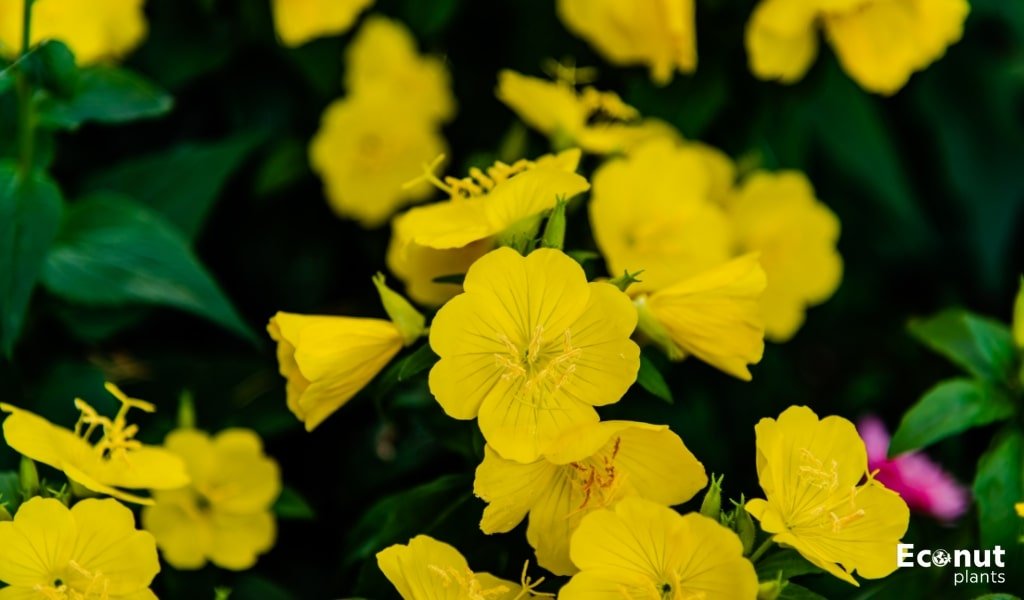Sundrop Plants are hardy, low-growing perennials that like the summer heat. The plant has a woody base and can reach heights of one foot and widths of three feet as a tiny subshrub. Hundreds of 2-inch-wide golden blossoms emerge in the early summer and spring.
The display lasts for four to six weeks, and with the right conditions, it can rebloom all summer long and into autumn, but individual flowers only last a day. This is how to cultivate Sundrops in your yard.
Sundrops Plant Overview
| Scientific Name | Oenothera fruticosa |
| Family | Onagraceae |
| Zone | 4-9 |
| Height & Spread | 1-3′ tall |
| Light | Full sun |
| Soil | Well-draining soils |
| Water | Tolerant of dry conditions |
| Pests & Diseases | Rabbits, Etc. |
Where to Sundrops Plant
Sundrops are most at home in their native regions, which are the South Central, Gulf, and Oklahoma states. This plant needs full light to absorb some heat from the sun.
Because of their bright yellow blossoms and tidy habits, sundrops are a great choice for pavements and border garden fronts. Reduce sharp edges by letting sundrops cascade over the patio and concrete edges.
When and How to Sundrops Plant
Sundrops can be planted at any point during the growing season; however, late spring or early summer are the ideal seasons to plant them. Just be sure to handle them carefully.
After planting, make sure to give the sundrops lots of water. To help the plant maintain moisture while it adjusts to its new environment, you can add some aesthetic value to the area surrounding the plant base by adding some gravel or mulch.
Sundrops Plant Care
The perennial sundrop plant requires very little upkeep. You may learn how to properly care for your yellow sundrops flower from this post.
Light & Temperature
These plants, which are members of the primrose family, grow most successfully in USDA hardiness zones 4 through 9. They claim to be sandy and sunny. They can be grown in some shade, even though they prefer full sun.
The minimum temperature needed for these plants is -33 °F. Early spring is when they first emerge, and late spring or early summer is when they begin to blossom. Then, in the autumn, they rise again, according to their regular life cycle.
Water
Make sure to water your plant sparingly because it is not very thirsty and can withstand some drought conditions. It’s ideal to use medium wetness while sowing seeds. Once they begin to bloom, irrigation will not be necessary.
Soil
The pH range of 5 to 6 is ideal for these plants. Well-draining, fairly fertile soils are ideal for growing flowers. These plants might have dry to medium soil moisture requirements. Though well-drained soils are essential, these beautiful flowers can still thrive in poor soils.
Fertilizer
Native to areas with poor soil fertility, this perennial grows naturally. Over-fertilizer could make the plant dwindle.
If required, fertilize in the spring at half intensity with a balanced, slow-release fertilizer. Throughout the year, resist the impulse to apply more fertilizer. In poor soil, this plant thrives.
Pruning
If your Oenothera dies back after summer flowering, you can encourage new growth by pruning the stems to the base rosette. Other than getting rid of any plants that have expanded outside of the region you want to develop, you won’t need to prune.
Potting and Repotting Sundrops
Sundrops thrive in both big and small pots. Their long bloom season and innate tendency to spread make them the ideal “spiller” for mixed planters. To help lower the moisture content of the root zone, individual plants can be planted in small clay containers. Plants rarely need to be repotted.
If you live somewhere where winters are wet, cover the pot to relieve the anxiety of excessive precipitation. The plant may suffer from cold weather and excessive wetness at the roots.
How to Propagate Sundrops Plant
Sundrops can be multiplied by using cuttings or seeds from established plants. It can be challenging to gather the little seed. As soon as autumn arrives, start a new seedling in the garden.
To ensure you don’t miss out on the small seedlings, mark the spot where the seed should be planted and monitor it throughout the spring. After trimming the bottom leaves from the cuttings, place them in a lightly watered potting mix and place them on low heat.
Once or twice a day, lightly spray the plants by covering them with a transparent cover or by placing them under a misting device. While it shouldn’t be kept wet, the dirt shouldn’t be allowed to get entirely dry.
Troubleshooting
Growing this plant is quite simple because it is resistant to pests and illnesses. However, your fruticose Oenothera can be experiencing any of the following growth problems:
Growing Problems
For your Oenothera fruticosa to grow, bloom, and develop in your garden, make sure it receives at least six hours of direct sunlight each day. Your plant enjoys dry soil, so avoid over-fertilizing or watering it.
Pests
It is pest-resistant. Although a few sly critters might nibble on it, it shouldn’t become an issue.
Diseases
It is resistant to all illnesses, except a few tiny leaf spots that cause very little damage. Your primrose won’t have any significant health problems. This makes it an excellent plant to nurture!
FAQ
A deer eating sundrops plant?
Deer that are ravenous would gladly trudge through a garden and eat anything they can find, but they don’t appear to care for sundrops and will often ignore them in favour of more appetizing foods.
My sundrops withered away. Sundrops are perennials, right?
Sundrops are annuals, meaning they grow back every year, but they only live so long. You might notice that your plant becomes weaker and eventually dies after three or four years of healthy growth. Allow sundrops to self-seed in your garden to maintain this plant’s legacy.

